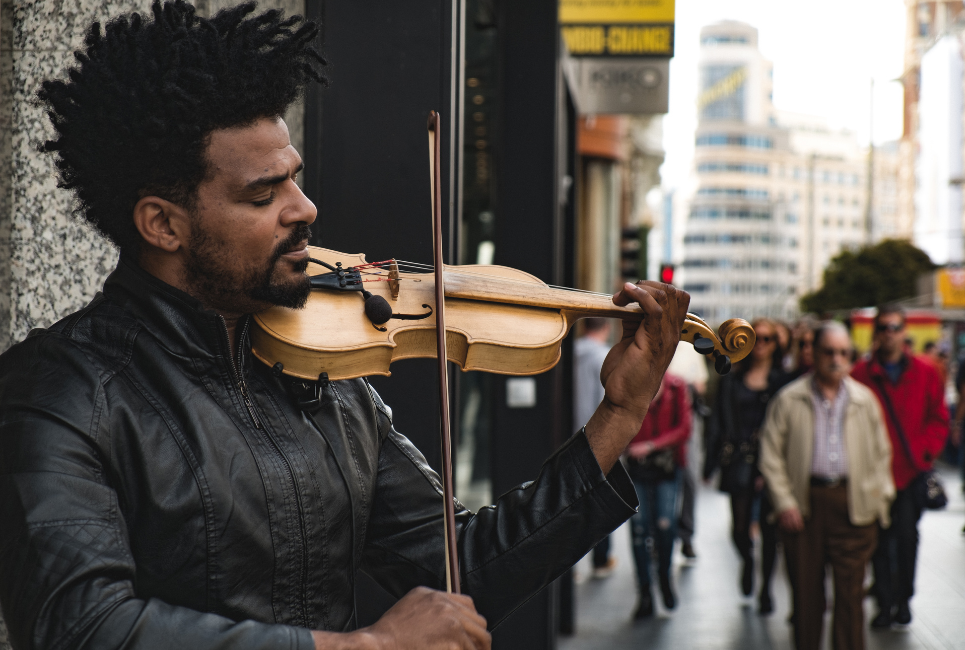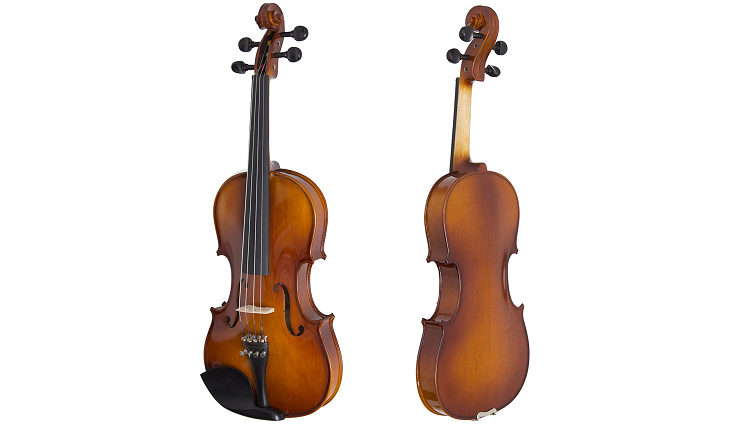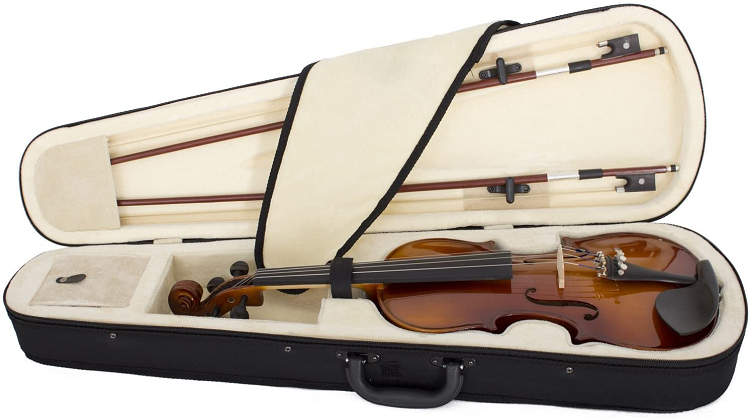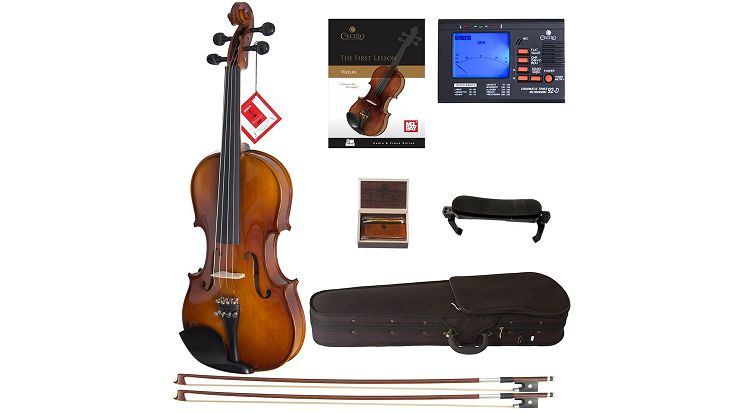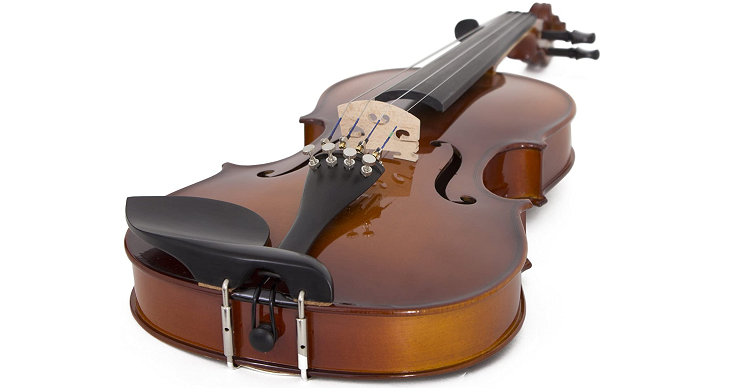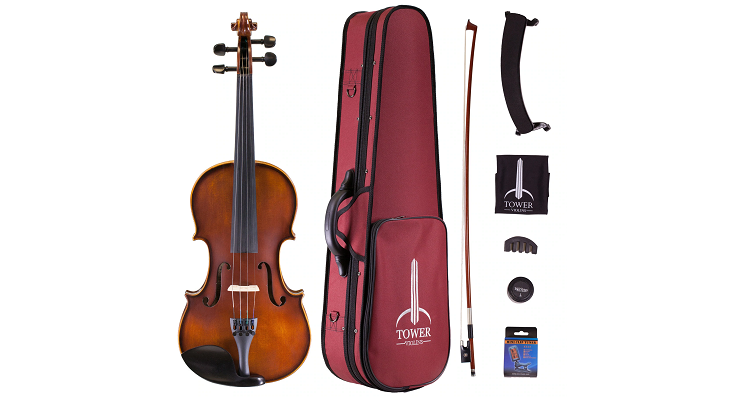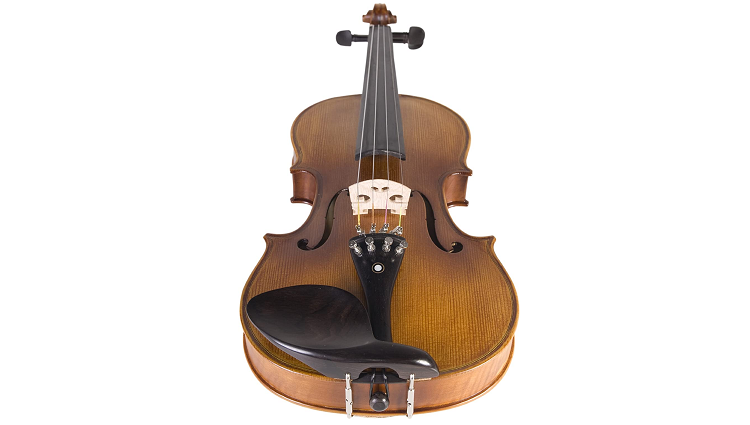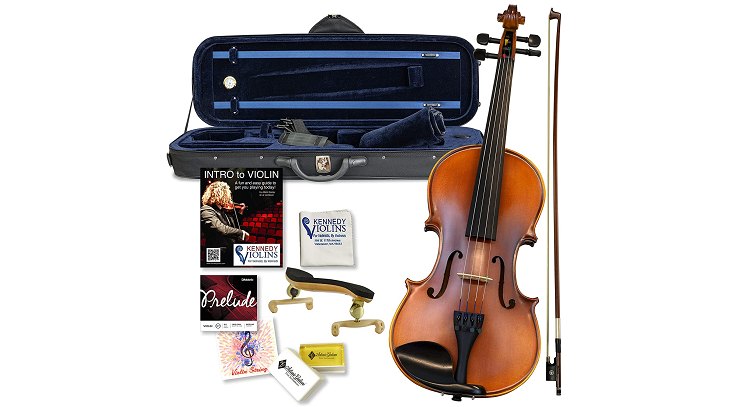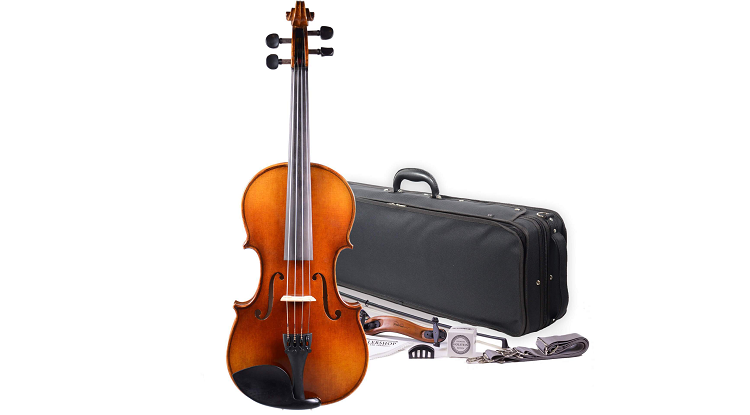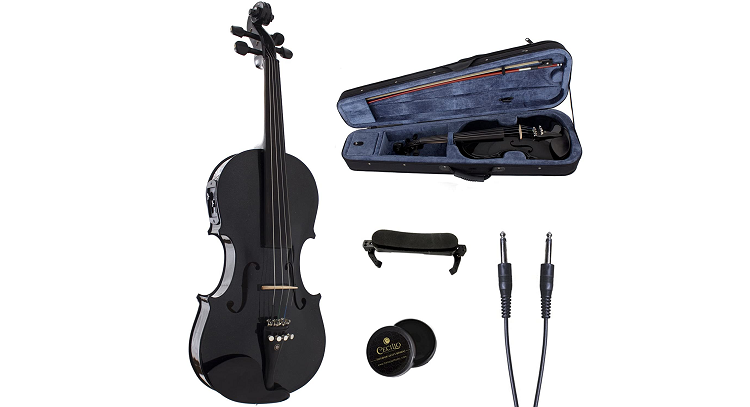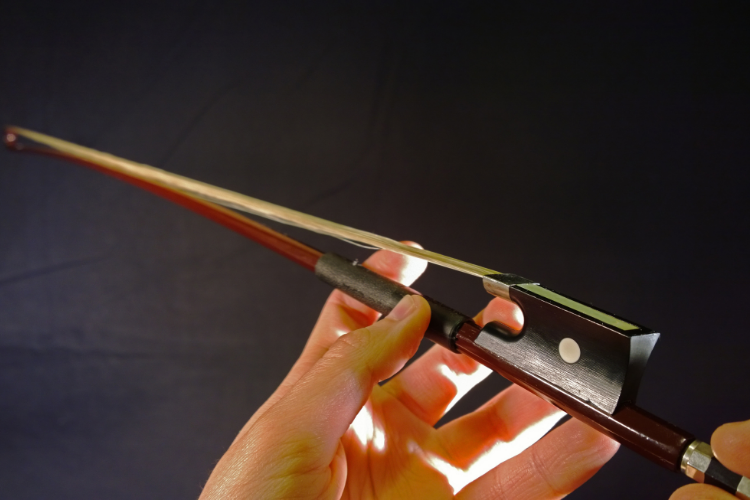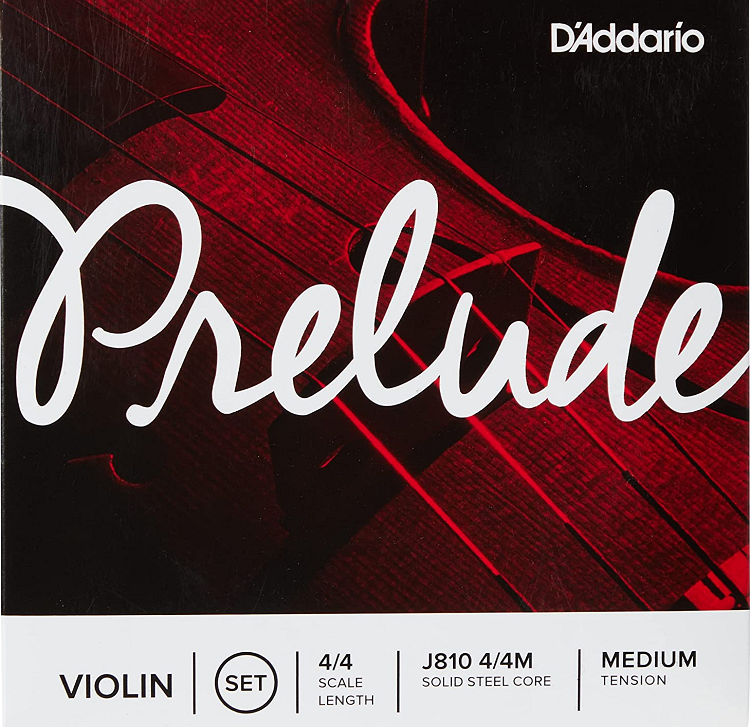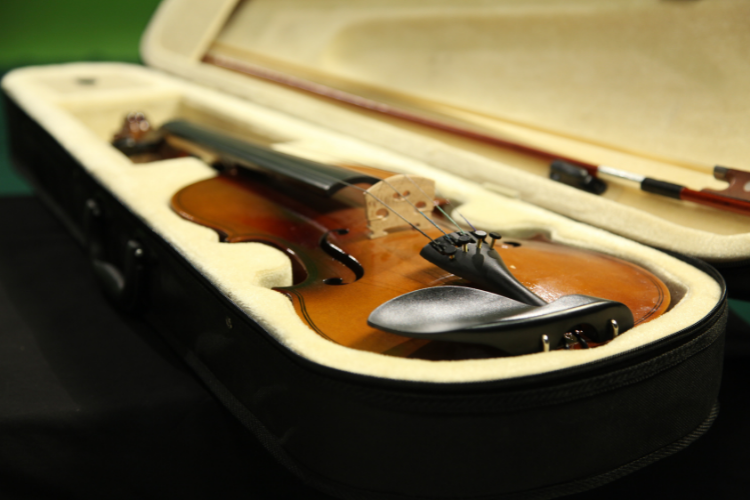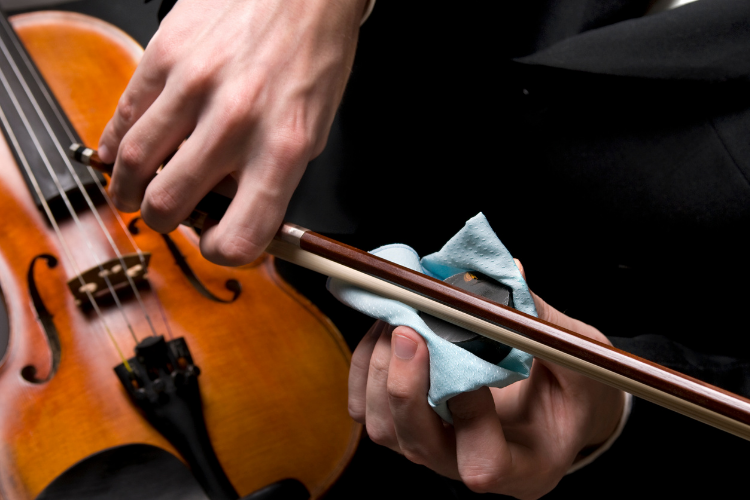- Best Fretted Violins Guide - May 31, 2022
- Best Yamaha Violins Brand Guide - April 13, 2022
- An Honest Mendini MV300 Review - March 31, 2022
Cecilio and their company Mendini are well known for making budget student instruments. Some of these instruments are toys, but others are actually decent. At least until you can upgrade to something better. The CVN 300 is, in my opinion, the first actual playable instrument in the Cecilio lineup.
I had the pleasure and frustration of using the acoustic-electric version of this instrument as my first violin. The only difference is the added electronics and weight.
The playability, tone, and overall construction are pretty much the same. I enjoyed many things about this violin but compared to my current violin, there are several issues as well.
Pros, Cons, and Bottomline
The CVN 300 is a pretty basic violin; the best thing is how inexpensive it is. The CVN 300, 400, and 500 are the only violins on the market that comes in under 200 dollars and are actually playable. It won’t win any awards, and some may scoff at the idea of starting on such a cheap instrument.
Still, if this is what you can afford and what gets you into the violin, then this is a good violin. It has the basics for what I consider a decent budget violin, and for its price, you have some more freedom to what you can do with it. But it requires some tweaking to use its full potential.
If you have the funds to upgrade to the CVN 500, you’ll be getting a slightly higher quality instrument that will have a better overall tone and feel. Suppose Cecilio doesn’t strike your fancy and you are comfortable with renting.
In that case, I suggest going that route and contacting a local music store. And if you don’t want to rent and don’t like the Cecilio models, I have some alternative picks below. Just keep in my mind they are more expensive.
Pros
- Very inexpensive for a starting violin
- Complete outfit with mostly usable accessories
- Very pretty color overall
- Suitable for a student
Cons
- Will require bridge installation best done by a luthier, which can be expensive
- Will start to fall apart within about 3 years.
- Poor quality fine tuners and included bows
- Cecilio instruments suffer manufacturing defects
Budget Violins: Good and Bad
Budget violins and other instruments are rather peculiar. I don’t find these aimed at small children but rather older new players. Typically someone who is 13 but more likely an adult. At this stage, renting doesn’t always make sense since you no longer need to exchange your instrument every few years.
It’s also an added monthly expense that not everyone feels comfortable with or wants to think about. If you don’t live near a rental store, you will be stuck with online rental options, which in my experience, don’t have the best rental terms.
In these situations, budget violins are good options for those with a limited budget where spending 5 or 600 isn’t an option. It certainly worked for me!
If you have a small child using fractional instruments, I suggest renting. Part of this is the general hassle of trading in or selling the smaller violin for a new one, and the other part is just how quickly it can happen. Children grow fast.
They may be comfortably playing their 1/2 sized violin one month and ready to upgrade by the next. The cost of this can sneak up on you, and if your kid is going into 3/4 or full size, you’ll want to get them something decent.
Renting helps in that respect by allowing you to build credit towards purchasing a violin. The rental terms can vary, but the best ones are found in local mom-and-pop stores.
Minus the insurance cost, I usually see 80 to 100% of your rental payment toward your credit balance. Online I typically see 50% the most often, which means you lose a decent chunk of money.
This isn’t horrible for a child trading up because you’d lose money and time either way. For those needing a full-size violin to start, it’s frustrating, and budget violins help fill that gap.
If you don’t want to rent a violin or are sentimental like myself, I suggest purchasing the best thing you can get at the lowest cost. The CVN300 is available down to 1/32 size, but they can be harder to track down the smaller they get.
Budget Violin Means Budget Construction
The biggest problem with budget violins is their construction. This ranges from the type of tonewoods used, the construction method, and the fittings and accessories included. Violins should be made from solid carved spruce and maple tonewoods carved with an arch that gets slightly thicker near where the soundpost, bridge, and F-holes sit on the top of the violin.
Cheaper modern violins are made from thinner woods which are brighter and responsive at first but slowly become screechy over time. In contrast, higher-end violins and antiques will be made with thicker wood.
These violins will need a longer break-in period. Still, they will sound better over time and age-appropriately, not the other way around.
You will find violins made from unaged wood sourced from young trees along with thinner tonewoods. This lends to the bright, empty student tone, but this isn’t exclusive to Cecilio. Many student instruments are made with younger trees. The extremely cheap violin toys have lower-quality fittings and fingerboards.
The worst will be made from dyed hardwood, but I usually see maple. I don’t mind maple on cheap instruments too much as it’s not meant to be a forever violin, but I still prefer ebony.
Fittings vary outside of dyed wood. Ebony and boxwood are the most popular. I prefer rosewood. The pegs may or may not be properly reamed; they should turn smoothly and stay in place quickly.
Budget instruments are typically made to be passable in terms of playability. Still, the included accessories, and many, are complete junk. There are a few expectations, but for the most part, violins don’t come with extra bows or bridges unless those things are prone to failure.
With all of this in mind, it’s important to remember that these violins aren’t meant to be with you for more than 3 years or so. The budget construction isn’t that big of a deal if you have set your expectations appropriately.
Make a plan to save for an upgrade or work towards financing a better violin. In the meantime, some tweaks can make most budget violins sound a lot better.
Cecilio CVN 300 Info and Review: My Honest Opinion
Cecilio violins hit the mark when it comes to budget construction. The CVN300 is a bit better than the 100 and 200 in terms of material, but method of construction is the same. The body has the typical spruce and maple, and the fingerboard is ebony along with the fittings.
The tonewoods are sourced from China, but I’m not sure where. It’s not uncommon to have tonewoods sourced from higher altitudes in China, but it’s typically specified in what region. I’m assuming Cecilio has their own tree farm. They seem to do most things in house and stay pretty silent about it.
The tonewoods aren’t unique in any way, and they have likely been carved using machine tools over hand tools. For the price, I expect this. I don’t expect to find aged tonewoods that have been sourced from special areas in a violin this cheap.
The fingerboard, fittings, and overall are my most significant point of concern. The setup on a violin is essential from a correctly carved fingerboard and bridge with precisely measured strings.
An amazingly made violin will sound poor if the setup isn’t correct. Cecilio will often set up the violin and then loosen the strings and take the bridge down during shipping to avoid damage. This results in a bridge that a new student will have no idea how to set up.
In my opinion, it’s best to take your violin to a luthier and have them perform a full inspection and set the bridge. The fingerboard and bridge seem to be the biggest victims of quality controls.
Fingerboards and bridges should be fitted to each instrument individually. Since mass-produced instruments follow the same pattern most of the time, the fingerboard will be okay. However, things go wrong when something goes different during production to produce a slight variation, and the fingerboard isn’t adjusted.
Most setup issues I see involve replacing the bridge and replacing the fingerboard, so it’s correctly shaped to the instrument. The CVN 300 comes with D’Addario Prelude strings, a pretty standard new student string.
I wouldn’t bother changing these out like you have to with Mendini instruments; this saves a good 30 dollars off the cost of getting a good setup.
If you feel confident in your ability to inspect your new violin or set the bridge, do so at your own risk. I did it with mine, but I had pickup marking where the bridge went. It played fine until it didn’t.
The outfit on these violins consists of a small triangle case, a shoulder rest, rosin, tuner, and lesson book. It also comes with two bows, but they are of pretty poor quality.
Brazilwood bows are great new students, but they still need to be well-balanced and use quality horsehair. These bows are more likely to break or become warped than something of a higher quality. I recommend throwing them out and purchasing an excellent student-quality carbon fiber bow from Cadenza or Fiddlershop.
A Violin or Dying Cat?
Regardless of what violin you buy, you will sound like a dying cat at first. The violin is hard to master, and intonation takes years to develop properly. A poorly made violin will make that sound even worse. You should never sound bad because of your violin, just your playing level.
The CVN300 is a student instrument, so you won’t find a lot of personality or oomph behind the tone. It doesn’t have an overall bright or deep tone, but it is very crisp and clear, perfect for students.
Student violins tend to have an empty, crisp, and often bright tone. I’m not a fan in general, but it’s excellent for starting students, as they won’t be able to appreciate the nuances of tone and personality quite yet.
I found the violin to be playable, but I noticed I had an easier time getting an even tone out of my new violin. After about three years, I did start to see the breakdown of both the instrument and its tone. The fine tuners were the first to break after about 6 months.
The bigger problem came when the varnish started to crack and flake despite being handled with care. At this point, I had outgrown what I could learn on this violin and upgraded to an Eastman VL305 anyway. I suspect that most new students who enjoy the violin will want an upgrade around the 2 to 3-year mark.
Alternatives to the CVN 300
Cecilio violins might not strike everyone’s fancy; despite the cheap price tag, a little research will show you that you can get a higher quality student instrument for not much more. In fact, with the cost of a professional setup, you will probably pay a similar price. But have to go through a lot more work to get there.
You will save money if you forgo the setup, but you run the risk of unknown defects or simply not getting the most out of the violin. These picks take care of that. While more expensive, they are made with higher quality materials, a proper setup, and suitable quality accessories. I’m confident you will like one of these along with brand reputation!
Top Pick- Tower Strings Entertainer Violin
The Tower Strings Entertainer by Fiddlershop is one of my favorite low-cost violins. It’s about 70 to 100 dollars more than models from Cecilio. Still, it’s of much higher quality and goes through a full inspection by actual luthiers. Its made from dried tonewoods, with an ebony fingerboard and pegs.
It has a carbon composite tailpiece with decent fine tuners that will last. Mine is going on 5 years. Fine tuners that break are really annoying, especially for new students. Tuning by pegs is always the goal, but it can be difficult to get a precise tune even as an advanced student, and quality fine tuners are a must.
Along with a well-made violin, it will also be set up using their 10 point inspection in Fiddlershop’s Miami workshop. It comes actually ready to play out of the case with accessories I don’t hate! The case is a small triangle shape with enough space to hold rosin, a polishing cloth, and your shoulder rest.
The bow is a basic brazilwood bow; I still use mine occasionally. It plays well and is easy to control. The shoulder rest is excellent; I prefer it over other cheaper ones. I recommend an eventual upgrade to their carbon fiber one with the screw-in feet. It’s much sturdier but less adjustable.
The rubber mute is great for quiet practice; I’ve had several; my only concern is the black marks they leave on the bridge. Harmless but ugly. For the price, you can’t beat the quality. That is why this is one of my go-to recommendations when someone is looking for a quality, affordable violin.
Budget Pick- Cecilio CVN 500
If you need a budget pick, I recommend the CVN500. It’s not much cheaper than the Tower Strings, but it’s a great violin if you need to save some money and feel confident in setting the bridge yourself. If you need someone to fix the bridge, you are better off with the Tower Strings violin. Its made from solid spruce and flamed maple.
It has all ebony fittings and fingerboard as you would expect, along with an essential tailpiece and fine tuners. The outfit includes the same basics as the CVN300 and will need the same upgrades to the bow. It’s a beautiful violin with a slightly sweet and bright sound.
For the price, it’s the one I generally recommend if someone asks about Cecilio violins. I also love the CVN600, but at 300 dollars, I would recommend the Tower Strings Rockstar. Unless you are confident in setting it up yourself, in that case, both are very lovely violins.
Step Up Violin- Bunnel G2 Violin Outfit
Kennedy Violins has been around for over 15 years. They have a bit of a reputation because they sell on Amazon. Still, a quick Google search pulls up their main website and storefront location. They offer most of their student violins on Amazon, allowing them to reach a wider audience and help more people start their goals of learning the violin.
I can respect this and feel confident that they offer quality violins similar in quality to Shar and Johnson Strings. They rent to the local area and have a nationwide program at affordable prices. If you live near Vancouver, Washington, this might be a store you would go to if someone suggested a local luthier; they just happen to sell online as well.
The Bunnel G2 Violin Outfit is one of their more expensive violins. Its made from handcrafted tonewoods and ebony fittings. It has a carbon composite tailpiece with built-in fine tuners, similar to Wittner tailpieces. It’s set up with Prelude strings and quality checked in Washington, so you received an instrument that doesn’t need any adjustments.
It has a gorgeous antique finish and is incredibly responsive when playing. You won’t have to work very hard to get a good sound out of this violin. I do find the lower register a little empty and too bright.
The outfit includes an upgraded case, Guiliani Premier Bow, Shoulder Rest, extra strings, and an intro to violin book.
Expensive Student Violin- Fiddlerman Artist Violin
The Fiddlerman Artist is still considered a beginner violin. Still, it could easily stay with a student for several years. It’s a great deal more expensive than either of these picks. It would make an excellent upgrade from a Cecilio or Tower Strings violins. This violin is made from aged figured spruce and maple tonewoods.
A hand-carved French Despiau or Helstein 3 star bridge. The varnish is hand applied for an even and beautiful look and the standard carbon composite tailpiece with built-in fine tuners.
Like the Tower Strings instruments, it comes fully set up and ready to play out of the case. This violin comes with either Kaplan Amo or Thomastik Dominant strings which are nice synthetic strings.
The outfit includes a nice oblong case with plenty of storage, a carbon fiber bow, shoulder rest, rosin, mute, and tuner. Basically, everything you need as a new player and great accessories for a seasoned player. The tone of this violin is lovely and clean; I really enjoy listening to it. Each register compliments the other, which is lovely.
CVN-AE – Acoustic-Electric Violin
The CVN-AE is the Acoustic Electric version of the CVN 300; construction and looks-wise, it’s nearly the same. You can get it in the traditional antique varnish, black or white. I’m not sure what electronics they use in this violin; I assume they use in-house electronics or source from a cheap Chinese source.
I’ve found the same exact style pick-up on eBay and Aliexpress before. On the one hand, cheaper electronics are why this violin is so cheap compared to, say, a Glasser, which uses custom Bartoli electronics (of course, the carbon fiber will add a pretty penny too). On the other, cheap electronics are prone to breaking and even starting fires.
I never had any problems with fire, but I’ll be honest, I’m not entirely sure the silent practicing function ever worked on my violin. She did sound great hooked up to an amp, though!
The electronics added a significant amount of weight to the violin as well. This made it harder to hold and play as a beginner. The difference between the violin with and without the pickup was very noticeable. I wish I had weighed the violin before and after taking it out. I wouldn’t recommend this version in general, much less for a beginner.
Always learn with a pure acoustic violin for at least the first year and continue to play an acoustic violin regularly. I don’t know anyone who exclusively plays an electric or acoustic-electric violin, even if they regularly use one.
The nuances in tone and the ease of playability in a well-made acoustic violin will help students grow and learn how to control their bow and other advanced techniques better. The weight of acoustic-electric violins makes them more difficult to play. The lack of nuance on an electric means that a student won’t learn how to produce a good even tone organically.
Best Violin Accessories for Beginners
New students will need accessories for their violin; some aren’t really accessories but essential aspects of playing the violin. In other words, without these, you have an ornately carved wooden box.
Many student outfits come with most if not all of these accessories, but you’ll find your preferences over time and switch out or trade up. If you get a Cecilio violin, you will want to upgrade many of the accessories either right away or within six months to a year.
Essentials
To play the violin, you need your violin setup with strings, a bow, and rosin. You also need a case to keep your instrument in and preferably a shoulder rest, but it’s unnecessary.
Bows
Bows are incredibly important; they draw the sound from the violin. Well, with the help of rosin. My favorite bows are from Fiddlershop, specifically their Carbon Fiber Line.
For under 100 bucks, you get a great well-balanced bow that’s extremely durable for kids, especially. The more durable, the better. I also love Cadenza bows made by Eastman. They are easy to use and incredibly lightweight but more expensive.
Strings
Strings are another essential item for a violin. For students, D’Addario Prelude strings are pretty standard. I used Pro-Arte’s before moving to Dominants and then Fiddlershop strings.
I’m currently using Thomastik Infield Vision strings. Ultimately I recommend sticking with steel core strings like Preludes for at least the first 6 months. They are incredibly strong and resistant to temperature change meaning they hold their tune well.
Rosin
Rosin is a substance made from sticky pine resin that is boiled to remove the terpenes and cool in a mold. There are so many different kinds of rosin out there. Cecilio comes with a basic cake, which I remember is alright. I used Magic Rosin for a long time, and I’m currently using Kaplan Dark. My preferences have never leaned one way or another.
Magic Rosin is one of the coolest to give as a gift because of the picture on the bottom of the cake. You can even get a custom picture; I chose my dog!
Shoulder Rests
Shoulder Rests are pretty individual over time. I hate the Cecilio shoulder rest and got a carbon fiber Fiddlershop one. I used it for a while, but it wasn’t with its problems either, particularly the feet coming off. I recently got the new version of it, and it’s a huge improvement with screw-in feet that barely swivel. 20/10 recommend!
Kun is another brand of loved shoulder rests among violinists. You don’t need one to play the violin but I highly recommend it for beginners; otherwise, it can be uncomfortable to play long periods of time.
A Case
A Case is a must-have to protect your violin. Most instruments come with a case of some sort; student violins usually come with tiny triangle cases. I won’t dance around the subject; I hate them. Too small to hold anything comfortably and has no strap or pocket for your shoulder rest.
I like oblong cases with hydrometers and temperature monitoring, but I don’t have an absolute favorite…yet! My current obsession, of course, comes from Fiddlershop, but there are so many great cases out there. Bobelock is a great well price case brand, and Bam is extremely well known for its durability.
They have a ton of different shapes and colors, so you can find something to suit your needs. My best advice is to avoid cases that aren’t from well-known makers. This is your instrument protection from the outside world, and it needs to be of good quality.
Tuners
Tuners come in so many different forms. I suggest avoiding clip-on tuners, they can damage your violin, and there really aren’t my great places to put them. Get a decent stand-alone tuner with a metronome. Or, if you can’t be bothered, there are many apps out there that also work really well.
I’m not sure if it’s sacrilege to use your phone for tuning in the violin world, but I do. I also tune using my computer with Smartmusic; this works well if you have a good mic setup. I have a Blue Yeti; it’s not the best for instrument recording, but it works really well with Smartmusic for tracking my progress, testing myself, and of course, tuning.
Violin Care and Learning Aids
Violin Care and Learning Aids consist of various extra things you may or may not buy with your violin. This typically includes a polishing cloth to keep your violin clean and free of dust and extra rosin. Polishing and cleaning formulas can also be bought from various companies. I used Hill’s branded polishing formulas in the past.
Learning aids usually consist of your method book, which will be assigned by your teacher, usually Suzuki or Essential Elements, and fingerboard tape. Fingerboard tape helps you learn the placement of your fingers by sight, not just the ear.
Developing the ability to hear subtle differences in intonation while playing can take a while; new students often need visual aids. Over time muscle memory will develop, along with your ear, and you won’t need the fingerboard tapes anymore.
FAQs
Answer: Generally no, they use hair from the tails of horses. You can get vegan bows now with synthetic hair from Zarelon. Aaron and Fiddlershop currently sell carbon fiber bows; the cool thing is that the hair comes in different colors.
Answer: If it’s a poorly made cheap violin will never sound good. But a good setup will go a long in making a violin-like CVN300 sound its best. Upgrading the bow and changing out strings to higher quality or synthetic strings.
Answer: This is subjective; someone may find their 500 dollar violin to sound better than a 1,000 dollar violin. It’s down to your personal preferences. I recommend spending about 250 dollars on getting something fully set up with quality accessories for students.
Answer: I would not suggest starting with an electric violin. Electric violins are great for advancing musicians who are ready to expand their repertoire and test and advance their skills in what they can do with their instrument. Beginners need a good quality, a well setup up acoustic violin to learn the basics properly.
An acoustic violin’s sound comes from the F-holes, bridge, and the vibration from the strings. This also provides feedback on how you are playing, whether it’s a scratchy bow or you keep screeching on the E string.
You won’t get those same nuances in tone and feedback from an electric violin because the sounds travel through electronics first and come out flat and without personality. Personality is then given back in the form of effects, reverb being the most common.
Final Thoughts
The CVN300 is an excellent budget violin, and it’s perfect for a new student who wants to dip their toes in the water. It’s not the highest quality starter violin, but it will work for the first few years. However, requiring a full setup will cost about the same price as purchasing a higher quality violin from Fiddlershop or Kennedy Violins.
Looking for more interesting readings? Check out:

